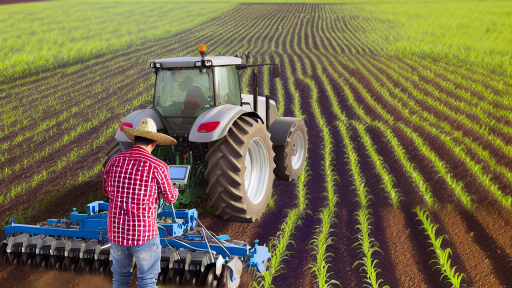Understanding Emergency Financial Aid Programs for Farmers
Overview of Emergency Financial Aid
Emergency financial aid programs help farmers during crises.
These crises may include natural disasters, market downturns, or health emergencies.
They provide essential support to sustain farming operations.
Farmers can access various types of aid depending on their situations.
Types of Emergency Financial Aid
Several programs offer financial assistance to farmers in need.
- Disaster relief programs provide funds after natural disasters.
- Emergency loans help farmers recover from losses.
- Grants may support specific projects or initiatives.
- Insurance programs mitigate risks and provide payouts.
Eligibility for Financial Aid
To qualify for aid, farmers must meet specific criteria.
These criteria often include operational income levels.
Additionally, they may depend on the type of disaster experienced.
Documentation of losses is often necessary for reimbursement.
Steps to Access Financial Aid
Farmers should follow a step-by-step process to apply for aid.
- First, identify the type of aid needed based on circumstances.
- Next, gather necessary documentation about losses and expenses.
- Then, complete the required application forms.
- Finally, submit applications within the specified deadlines.
Resources for Assistance
Farmers can find assistance through various resources.
Local agricultural offices offer guidance and support.
Online platforms also provide information about available programs.
Nonprofits and industry organizations may help farmers navigate applications.
Types of Financial Aid Available
Grants
Grants provide funds that do not require repayment.
Transform Your Agribusiness
Unlock your farm's potential with expert advice tailored to your needs. Get actionable steps that drive real results.
Get StartedVarious organizations and government agencies offer these funds.
They often target specific agricultural needs and projects.
Application processes can vary across different grant programs.
Farmers should research eligibility criteria carefully.
Loans
Loans are a common form of financial aid for farms.
Farmers can access loans from banks and credit unions.
Government-backed loans often provide favorable terms.
These loans typically have lower interest rates.
Repayment plans depend on the loan type and lender.
Farmers should assess their ability to repay before borrowing.
Subsidies
Subsidies are financial supports provided by the government.
These supports aim to stabilize farm income and prices.
Eligibility for subsidies often hinges on specific crop production.
Farmers should stay informed about available subsidy programs.
Regular changes in policy may impact subsidy access.
Understanding the terms can maximize benefits from subsidies.
Eligibility Criteria for Accessing Financial Aid for Farms
Understanding the Basic Requirements
Farmers must meet certain basic requirements to access financial aid.
Each aid program has specific eligibility criteria.
Additionally, eligibility may vary based on geographical location.
Firms must be active agricultural operations to qualify.
Ownership and Operational Requirements
Farm ownership is a key factor in eligibility.
Applicants must provide proof of ownership or lease agreements.
Moreover, farms must be operational for a specific period.
Typically, at least one year of operation is necessary.
Showcase Your Farming Business
Publish your professional farming services profile on our blog for a one-time fee of $200 and reach a dedicated audience of farmers and agribusiness owners.
Publish Your ProfileFinancial Status Considerations
Financial need significantly influences eligibility for aid.
Farmers must demonstrate financial hardship due to unforeseen events.
This may include natural disasters, market fluctuations, or health crises.
Income statements and financial records are often required.
Compliance with Agricultural Laws
Furthermore, compliance with local and federal agricultural laws is essential.
Additionally, farmers must adhere to environmental regulations.
Certification programs or licenses may serve as proof of compliance.
Failing to meet these laws can result in disqualification.
Application Process Awareness
Awareness of the application process can affect eligibility.
Farmers should familiarize themselves with deadlines and procedures.
Understanding the necessary documentation is also crucial.
Lastly, seeking assistance from agricultural organizations can be beneficial.
Discover More: Common Mistakes When Applying for Farm Aid
Steps to Apply for Emergency Financial Aid
Understanding Eligibility
Know the criteria for eligibility before applying for aid.
Most programs require proof of financial need.
You should also demonstrate how your farm was affected.
Additionally, some programs are specifically for certain crops or livestock.
Gather Necessary Documentation
Prepare all relevant financial documents ahead of time.
Include tax returns and income statements from your farm.
Make sure to gather records of damages incurred.
Keep accurate records of expenses and losses related to the emergency.
Identify Relevant Programs
Research local, state, and federal aid programs available to farmers.
The USDA offers various forms of assistance.
You can also check with your local agricultural extension office.
Networking with fellow farmers can also provide helpful leads.
Submit Applications Promptly
Fill out applications as soon as possible after identifying them.
Ensure you provide complete and accurate information.
Attach all required documentation with your application.
Double-check your application for any missing information.
Follow Up Regularly
Check the status of your application after submission.
Contact the relevant agency if you do not receive updates.
Be prepared to provide additional information if requested.
Persistence can help expedite the review process.
Discover More: Financial Assistance Resources for New Farmers
Common Challenges in Accessing Financial Aid
Understanding the Complex Application Process
Many farmers find the application process overly complex.
This complexity can discourage them from seeking aid.
Additionally, incomplete applications may lead to immediate rejections.
To overcome this, farmers should carefully read all instructions.
They can also seek assistance from local agricultural agencies.
Moreover, attending informational workshops can provide clarity.
Showcase Your Farming Business
Publish your professional farming services profile on our blog for a one-time fee of $200 and reach a dedicated audience of farmers and agribusiness owners.
Publish Your ProfileNavigating Eligibility Requirements
Eligibility criteria for financial aid can be confusing.
Often, requirements vary significantly across programs.
This confusion can lead to missed opportunities for assistance.
Farmers should create a checklist of eligibility criteria.
Furthermore, contacting aid program representatives can clarify doubts.
Addressing Financial Documentation Challenges
Many farmers struggle with providing adequate financial documentation.
Missing documents can delay or block access to aid.
Tracking farm income and expenses accurately is essential.
Farmers should maintain organized and updated financial records.
Using accounting software can simplify this process.
Overcoming Misconceptions About Financial Aid
There are numerous misconceptions surrounding financial aid programs.
Some farmers believe that aid is only for large farms.
In reality, many programs cater to small and mid-sized farms.
Informational resources can dispel these myths easily.
Furthermore, networking with other farmers can provide guidance.
Building Relationships with Financial Institutions
Farmers may feel intimidated when approaching banks or lenders.
This intimidation can complicate access to necessary capital.
Building relationships with local banks can ease this process.
Farmers should meet with financial advisors to discuss their needs.
Moreover, establishing a solid credit history is crucial.
Discover More: Comparing Different Farm Subsidy Programs

How to Prepare Necessary Documentation for Aid Applications
Understanding Required Documents
Start by identifying the necessary documents for your aid application.
Typically, you will need your farming operation records.
Gather financial statements that reflect your situation.
Additionally, include tax records from previous years.
Keep your insurance information handy as well.
Organizing Your Paperwork
Organize your documents in a systematic manner.
Create labeled folders for different categories of paperwork.
Use a checklist to verify all required documents are included.
Consider digital copies for easier submission.
Always back up your documents for safety.
Highlighting Key Financial Information
Make sure key financial data is readily accessible.
Provide a clear summary of your financial statements.
Include any outstanding debts related to your farming operations.
List your income sources for transparency.
Consider showing trends in your financial health over the years.
Collaborating with Financial Advisors
Reach out to financial advisors for assistance.
They can help interpret complex requirements you may face.
Additionally, they might provide insights into your financial statements.
Work with them to ensure your documentation is complete.
Showcase Your Farming Business
Publish your professional farming services profile on our blog for a one-time fee of $200 and reach a dedicated audience of farmers and agribusiness owners.
Publish Your ProfileUtilizing their expertise strengthens your application.
Reviewing Your Application Before Submission
Before submission, conduct a thorough review of your application.
Check for any missing documents or discrepancies.
Ensure your financial information is accurate and up-to-date.
Consider asking someone else to review your application as well.
This additional perspective can catch overlooked errors.
Discover More: Steps to Secure Financial Aid for Your Farm
The Role of Government Agencies and Nonprofits in Financial Assistance
Government Support Programs
Government agencies provide crucial financial assistance for farms in distress.
Programs like the Farm Service Agency (FSA) offer low-interest loans.
These loans help farmers recover from unexpected challenges.
Additionally, the FSA administers disaster assistance programs.
This ensures farmers receive timely support when emergencies arise.
Nonprofit Organizations’ Contributions
Nonprofit organizations also play a vital role in financial assistance.
For instance, the American Farmland Trust advocates for farmers’ rights.
They offer grants and funding opportunities to eligible farmers.
Moreover, nonprofits often collaborate with government agencies.
This partnership enhances the financial resources available to farms.
Application Processes
Accessing financial aid involves navigating specific application processes.
Farmers must provide relevant documentation to apply for assistance.
Common requirements include proof of income and operational status.
Additionally, some programs may require a detailed business plan.
Therefore, preparing these documents in advance streamlines the process.
Challenges in Accessing Aid
Many farmers face challenges when seeking financial assistance.
Limited awareness of available programs can hinder access.
Furthermore, the application process may seem complex and daunting.
In some instances, farmers lack the technical skills needed for applications.
Thus, targeted outreach and education are essential to improve access.
Success Stories
Several farms have successfully navigated these financial assistance programs.
For example, Thompson Family Farm received a grant from a nonprofit.
This funding allowed them to invest in sustainable practices.
As a result, their productivity and profitability increased significantly.
Such success stories encourage others to seek assistance when needed.
Case Studies: Success Stories of Farmers Receiving Emergency Aid
Success in the Face of Adversity
Maria Gonzales, a vegetable farmer in California, faced severe drought conditions in 2021.
Her crops suffered significantly, putting her family’s livelihood at risk.
She applied for emergency financial aid through the USDA.
Fortunately, she quickly received funds to sustain her operations.
With this aid, Maria was able to purchase seeds and irrigation equipment.
Today, her farm not only survived but thrived in subsequent seasons.
Innovative Solutions for Crisis Management
In Oregon, David Thompson runs a dairy farm.
Last year, heavy rains flooded his fields, threatening his cattle’s food supply.
Showcase Your Farming Business
Publish your professional farming services profile on our blog for a one-time fee of $200 and reach a dedicated audience of farmers and agribusiness owners.
Publish Your ProfileBy reaching out to the Farm Service Agency, he accessed emergency loans.
With these funds, David implemented effective drainage solutions.
Now, his farm is better prepared for future weather challenges.
Community Support and Resilience
The Johnson family operates a grain farm in Kansas.
After a tornado devastated their property, they sought help from local organizations.
With coordinated efforts, they secured emergency aid from various foundations.
These funds assisted in rebuilding their home and farm infrastructure.
Furthermore, their story inspired community donations, fostering resilience.
Today, they are back to production, stronger than ever.
Turning Challenges into Opportunities
Emily Park runs a flower farm in Texas.
In 2020, she faced a severe pest outbreak that threatened her blooms.
After applying for emergency aid, she received funds to invest in organic pest control.
This decision not only saved her crops but also positioned her for long-term success.
Now, she proudly markets her flowers as chemical-free and sustainable.
Accessing Resources for Recovery
Farmers across the nation are finding new ways to access emergency financial aid.
Many organizations and government programs provide necessary support.
Through proper channels, farmers can recover and thrive after disasters.
These success stories showcase the power of resilience in agriculture.
Additional Resources
The Emergency Food Assistance Program (TEFAP): Background …
United States Department of Agriculture FY 2024 BUDGET SUMMARY




